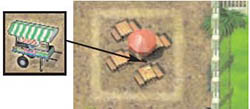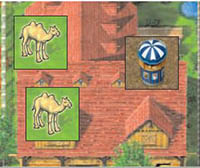
Each player is a zoo owner. Players score points by attracting as many visitors to their zoos as possible. To accomplish this, they must collect matching sets of animals.
If a player manages to obtain many animals for his zoo, he will find it worthwhile to expand his zoo. Once all the enclosures are occupied, newly acquired animals must go into the barn. Vending stalls next to an enclosure guarantee a minimum number of visitors.
At the end of the game, a player loses points for animals they have left in the barn. The player with the most points wins the game.
Components

- 5 Zoo Boards
- 5 Expansion Boards
- 5 Delivery Trucks
- 88 Animal Tiles (11x 8 Animals)
- 12 Vending Stalls (3x 4 Types)
- 12 Coin Tiles
- 16 Round Offspring Tiles (2x 8 Animals)
- 30 Coins
- 1 Round Wooden Disc
- 5 Summary Cards
- 1 Rule Booklet
- 1 Pouch
Setup
-
With 3 players, remove all animal and offspring tiles of two types from the game. With 4 players, remove all animal and offspring tiles of one type from the game. With 5 players, use all tiles.
-

Shuffle all square tiles face-down.
Count out 15 tiles and set them aside as a face-down stack for the end of the game. Place the round wooden disc as a marker on top of the stack.
Combine the remaining tiles face-down in multiple stacks of any desired height and place them in the middle of the table.
-
Place the round offspring tiles face up in a loose pile near the face-down stacks of animal tiles.
-
Place as many delivery trucks next to each other in the middle of the table as there are players in the game. Return unused trucks to the box.
-
Each player takes a zoo board and places in front of himself (his play area). He then places an expansion board face-down to the left of his zoo board.
Return unused boards to the box.
-
Each player takes two coins. Place the remaining coins in the middle of the table as the bank.
-
The players choose a start player using any method they prefer.
Game Play
The game lasts several rounds. On a player's turn, he must perform one of the following three actions:
- add a tile to a delivery truck, or
- take a delivery truck and pass for the rest of the round, or
- carry out one money action
The turn then passes to the next player in clockwise order. Once each player has taken a delivery truck, the round is over and a new round begins.
A. Add a tile to a delivery truck
The player draws and reveals the topmost tile from any stack and places it in an open space on any untaken delivery truck of his choice.
His turn is then over.
Each delivery truck has room for no more than 3 tiles. Should all delivery trucks already have 3 tiles on them, then the player cannot choose this action. He must then choose either action B or C.
Important: tiles from the stack covered by the wooden disc can only be drawn once all other stacks have been exhausted!
B. Take a delivery truck and pass for the rest of the round
The player chooses any untaken delivery truck and places it, along with any tiles on it, in his play area. He must immediately add the tiles from the truck to his zoo.
Important: a player may only choose a delivery truck on which there is at least one tile!
Once a player has taken a truck, he passes for the rest of the round and will not get another turn until the next round. Since all passing players will have delivery trucks in front of them, it is easy to tell who has passed in any given round.
When the player adds the tiles to his zoo, he must follow the following placement rules:
-

Animal Tiles
An animal tile may be placed either on an empty enclosure space or in the barn.
Important: no enclosure may contain more than one type of animal tile. However, a player may have multiple enclosures containing the same animal type.
If there aren't any legal spaces for an animal tile left in the enclosures, then the player must place the animal in his barn instead.
-
Vending Stalls
A vending stall may be placed on an empty stall space or in the barn. If there aren't any stall spaces left, then the player must place the tile in his barn instead.

-
Coin Tiles
A coin tile is added to any other coins the player has. A coin tile is worth one coin. Both are equivalent and may be used interchangeably.

-
The Barn

Important: players may have as many tiles and as many types of tiles (including both animals and vending stalls) as they wish in their barns.
Note: a player may choose to place an animal tile in his barn, even if he has an appropriate empty space in one of his enclosures.
C. Carry out one money action
The player may carry out one of the following actions, provided that he can pay for it. He may pay with any combination of coins and/or coin tiles.
The following money actions are possible:
- Remodel (Move or Exchange)

- Purchase or Discard a tile


- Expand the zoo



The placement rules described above must be followed when carrying out these actions.
Important: A player may never carry out more than one money action per turn. Therefore, a player wishing to carry out more involved remodeling projects will have to choose the action "carry out one money action" on multiple turns.
I. Remodel
Remodeling costs 1 coin, paid to the bank. A player may only remodel his own zoo.
There are two remodeling options: Move or Exchange.
Move
The player moves a single animal tile from the barn to an empty enclosure space or he moves any one vending stall tile from it's current location to any eligible space in his zoo.

Example: Anna has 2 elephants in her barn and 3 elephants in an enclosure. She moves 1 elephant from the barn to the enclosure. She now has 4 elephants in the enclosure.
Example (no pic).: Bert has a vending stall on one space and moves it to another empty stall space.
Exchange
The player takes all tiles of one animal type in either his barn or one of his zoo's enclosures and exchanges them with all tiles of one other animal type in another of his zoo's locations. An exchange must always involve exactly two areas and the animal types must be different. An exchange involving two areas with the same animal type is not allowed.
Important: an exchange is not permitted when one enclosure is too small to accommodate all of the new tiles that would be placed there or when one of the areas is empty.
Exchanging vending stalls is not permitted.

Example: Claus has 3 elephants in his barn and 1 panda in one of his enclosures. He exchanges the two animal types, after which he has 1 panda in his barn and 3 elephants in the enclosure.

Example: Doris has 3 elephants in one enclosure and 2 pandas in another. Through an exchange, the two animal types end up switching enclosures.
II. Purchase or Discard a Tile
For 2 coins, the player may either purchase an animal or vending stall tile from an opponent's barn or discard an animal or vending stall tile from his own barn.
Purchase
The player takes the animal or vending stall tile of his choice from the barn of another player and adds it to his own zoo.
- 1 coin goes to the other player,
- coin goes to the bank. Note: The other player may not refuse the purchase.
Discard
The player discards the animal or vending stall tile of his choice from his barn. The tile is removed from the game.
Both coins go to the bank.
III. Expand The Zoo

The player pays 3 coins to the bank and turns his expansion board face up. This expands his zoo by one enclosure and one stall space.
End of the Round
Once each player has taken a delivery truck, the round is over.
The players return the empty trucks to the middle of the table and the next round begins, starting with the player who took the last delivery truck in the previous round.
Note: if all players but one have passed, this player may continue to take as many turns as he can and chooses before taking the last delivery truck and passing!
Two Special Situations
A. Offspring

There are 2 fertile males and females of each animal type, distinguishable by the small symbols on their tiles.
When a player adds the appropriate partner for a fertile male or female is to an enclosure where the partner waits, the two immediately produce an offspring.
The player takes one of the appropriate offspring tiles from the supply and places it onto an empty space in the enclosure. Once placed, the offspring tile is treated like any other animal tile.
If there isn't any space left in the enclosure, the player must place the offspring in his barn instead.
Note: all that is required is for the male and female to be in the same enclosure - they do not need to be next to each other.
Each male and female can produce an offspring only once. So, for example, no offspring is produced when a third fertile animal is added to an enclosure that already has a fertile pair. Another offspring would only be produced when another partner, creating a second fertile pair, is added to the enclosure.
Important: pairs only produce offspring in enclosures, not in barns or on delivery trucks.
B. Last enclosure space filled

Whenever a player places a tile on the last empty space in one of his enclosures, he receives bonus coins from the bank equal to the number shown in the enclosure (if any are shown).
The player may also take coin tiles instead, should there be any in the bank. If the bank is empty, then the player receives nothing.
Exception: no bonus is awarded when all enclosure spaces are filled as a result of an Exchange action. There is also no bonus awarded if an offspring produced by the exchange fills the last space.
Note: for an enclosure with 6 spaces, there is no coin bonus!
End of the Game
The end of the game is triggered when a player draws and reveals the first tile from the stack covered by the wooden disc. The round is played through the end. Once each player has taken a delivery truck, the game is over and scoring takes place.
Scoring
Each player determines the positive and negative points he receives for his zoo and adds them up.
-
For the animals in an enclosure, the player scores points as follows:
-

For a full enclosure (all spaces filled with animals), the player earns the higher of the two point values shown in the enclosure.
-

For an enclosure with 1 empty space (all but 1 space filled with animals), the player earns the lower of the two point values shown in the enclosure.
-
For an enclosure with two or more empty spaces, the player only scores points if he has a vending stall on at least one of the stall spaces associated with the enclosure. In this case, the player scores 1 point for each animal in the enclosure.
If a player has an enclosure with two or more empty spaces and no vending stall in the stall spaces that are associated with the enclosure, he scores no points for the enclosure.
Note: when both stall spaces next to a 4-space enclosure are occupied, a player still scores only 1 point per tile.

Each enclosure has one or two space for vending stalls adjacent to it.
-
-
For each vending stall type on stall spaces, the player receives 2 points.
-
For each vending stall type in his barn, the player receives minus 2 points.
-
For each animal type in his barn, the player receives minus 2 points.
Example: Claus has 3 elephants in his barn and receives 2 minus points for them.
The player with the most points wins.
In the event of a tie, the tied player with the most coins wins.
If there is still a tie, the tied players rejoice in their shared victory!
Scoring Example

- In the expansion enclosure, the player has all spaces filled with zebras. The player scores the higher score: 9 points.
- In the elephant enclosure, a tile
ais missing. The player scores the lower amount: 5 points. - In the enclosure with the chimpanzees, two tiles
bare missing. Since there is at least one vending stall next to the enclosurec, the player scores 1 point for each tile: 2 points. - In the enclosure with the pandas, 2 tiles
dare missing. As there is no vending stall next to the enclosuree, the player gets no points: 0 points. - The player has 2 different types of vending stalls. For each type he scores 2 points: 4 points.
- For each animal type in the barn, the player scores 2 minus points of, regardless of how many tiles of the animal types are in the barn: -4 points.
Total =16 Points
2-player Variant
The normal game rules are in effect with the following changes:
- Each player takes 2 expansion boards, which he places face-down next to his zoo board.
- Remove all animal and offspring tiles of three types from the game.
- Place 3 delivery trucks in the middle of the table.
Draw three of the tiles removed from the game at random and place 1 face-down on one of the trucks. Place the other 2 face-down on a second truck. This blocks these 3 delivery spaces for the entire game.
Players may only choose to take a truck with at least one face-up tile on it. When a player takes a truck, he only takes and places the face-up tiles on the truck. The face-down tiles remain on the truck.
The round ends once both players have taken a delivery truck. Remove any face-up tiles on the remaining truck from the game.
Continue Reading


